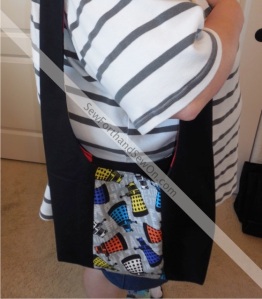 I believe I have fallen in love with bias tape.
I believe I have fallen in love with bias tape.
Even though, I had a number of trial and tribulations in the making of and the sewing on of the bias tape with these tops, I can see were bias tape can be a fun accent to many sewing projects and I can’t wait to start another bias tape project.
But before I do that I needed to finish these cross back summer tops before the summer has ended so that the girls can actually get some use out of them.
All I needed to do to finish them was to add buttons and buttonholes to the back of the tops and they would be done and ready to wear.
Sounds easy enough, doesn’t it? Well, I wish would have been as easy as it sounded.
 I knew when I cut this pattern out that this pattern does not have a true side seam. I did not think it was going to be a big deal, but it was!
I knew when I cut this pattern out that this pattern does not have a true side seam. I did not think it was going to be a big deal, but it was!
The backs are cut so that the shoulder and side seams are towards the front of the top. There is no seam directly under the armscye or on the shoulder. It is just to the side of the armscye and front of the shoulder.
This pattern also has no indication of where the buttonholes should be placed. So, when it came time for me to determine where to sew the buttonholes and buttons, I had some guessing to do. 
I started the guessing by trying to determine where the true side seam would have been on these tops. Should the back come towards the front of the top a little, like 1/2 inch, or a lot, like 2 inches.
Next, I had to determine if the cross over should match at the top and leave a big “V” at the bottom of the back or should the “V” of the cross over be smaller by lowering the top. I spent hours measuring, folding, pinning, and deciding where to put the buttons and buttonholes.
I would think that I had it all ready to sew, then I decided that it wasn’t right and I would start again. After awhile even the husband grew tired of me showing him each variation that I tried. He tried to help, but I just could not make up my mind if I had it right or not. 
Finally, I reached a point were I truly believed that I had it measured, folded and pinned where I wanted the buttons to be so I went to the sewing machine. I carefully sewed the buttonholes and buttons in place on both tops.
When I was done, I was quite pleased with myself until I held the tops up and the back curve of the cross over flopped down over one of the special buttons I had paid a lot of money for. Crap! The buttons needed to be higher on the top.
Now, how was I going to fix this? 
My first thought to solve this problem was to sew a hook and eye to the curve which would attach the curve to the back of the top. This would keep the curve from flopping over but that did not work. When the curve tried to flop over, you could see the hook and eye and it looked worse than the flopping curve of the fabric.
My next thought was to use some velcro. As I went to sew the velcro on, the husband asked what I was doing. I showed him the flopping curve and how I was trying to fix it. He said to stop. He said that since girls were sisters they could keep an eye on each other’s backs when they were wearing the tops and if the curve flopped, they could fold a crease in the bias tape so that the curve would not flop as much. This seemed like a reasonable solution to the flopping curve, so I left it at that.
 The REAL answer to this whole problem was to have the girls try the tops on before I placed the buttons.
The REAL answer to this whole problem was to have the girls try the tops on before I placed the buttons.
I could have quickly determined where the “side” and “shoulder” seams should be, how big the “V” in the back should be and where the buttons needed to be. But, I had wanted the tops to be a surprise for them so I didn’t. Even though they had picked out the fabric, they did not know what I was making from it. Plus, with them not knowing what or when I was making something, there was less pressure to get the tops completed.
With that all in mind, I determined that the surprise and less pressure to get the items completed were not worth the button/buttonhole headache, and with this lesson learned, the next time I make something for the girls, there will be fittings during the process. 
Upon receiving the tops, their mom says the girls like them and will wear them. I explained to their mom the button/floppy curve issue and she said it would not be a problem.
I don’t believe that the girls were nearly as excited about these tops as they were their fun vests or their Dr Who bags, but that is ok because I learned a lot from these tops both in the sewing process itself and in the process of sewing for others. 
And the next time I sew for the girls, I am getting them involved in the process.
No more surprises!
I want them to pick their own fabrics, colors and styles. I want to measure them so that I have the best fit, instead of using a year old measurement that their mom took (no offense to their mom), and I want fittings and alterations done during the sewing process.
I think I will learn even more sewing for them this way and they will have exactly what they want as well. Plus NO more guessing!
Until then, sew forth and bias tape on!



























 Oh, this is going to be fun!
Oh, this is going to be fun!





